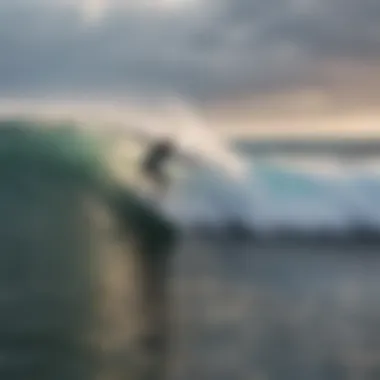Master the Waves: Comprehensive Surfing Lessons on Long Island


Surfboarding Techniques
Let's embark on a deep dive into surfboarding techniques, essential for mastering the art of riding the waves gracefully. Before venturing into the vast expanse of the ocean, understanding the varying types of waves is paramount. Each wave offers a unique challenge and opportunity, requiring surfers to adapt their skills accordingly. The pop-up technique, a fundamental maneuver for beginners, involves transitioning swiftly from lying flat on the surfboard to a standing position. This movement sets the foundation for more complex maneuvers, such as the bottom turn and cutback. The bottom turn maneuver is crucial for redirecting the board's trajectory along the face of the wave, showcasing precision and control. By mastering the duck diving technique, surfers can efficiently navigate through incoming waves while conserving energy. The cutback, a stylish maneuver involving a sharp change in direction, adds flair to a surfer's repertoire, enhancing both technique and aesthetics.
Surfboard Maintenance and Care
In the realm of surfboarding, caring for your trusty surfboard is as crucial as mastering techniques on the water. Proper maintenance not only prolongs the lifespan of your board but also ensures optimal performance. Begin with regular cleaning to remove salt, sand, and wax buildup that can impede your board's performance. Inevitably, dings and cracks may appear on your board after encounters with rocks or other hard surfaces. Knowing how to repair these imperfections is essential to prevent further damage. Waxing your board regularly provides traction, enhancing your grip while riding waves. Experimenting with different fin setups can enhance your board's stability and maneuverability, catering to your unique surfing style. Lastly, storing your board correctly, away from direct sunlight and extreme temperatures, is crucial to maintaining its structural integrity in the long run.
Surfing Destinations and Travel Tips
Exploration is at the heart of surfing, leading enthusiasts to discover top surfing spots worldwide. Whether you seek the adrenaline rush of big waves or the serenity of secluded breaks, choosing the right surfing destination is the first step. A well-planned surf trip involves meticulous consideration of factors such as wave conditions, local culture, and safety measures. To surf safely abroad, familiarize yourself with the local surfing regulations and respect the traditions of the host community. Immerse yourself in the vibrant culture of local surfing communities, gaining insight into their passion and rich heritage.
Surfboard Gear and Equipment
Equipping yourself with the right gear is essential for a fulfilling surfing experience, with different surfboards tailored to various skill levels and wave conditions. From nimble shortboards to graceful longboards and versatile fish boards, each type offers a unique riding experience. Essential accessories such as leashes, fins, and wetsuits play a pivotal role in enhancing comfort and safety while on the water. Choosing the right surfboard that matches your skill level and riding preferences is key to maximizing your surfing potential. Regular maintenance and upgrades to your gear ensure peak performance, allowing you to ride the waves with confidence. Embrace surfing technology and innovation, staying updated on the latest advancements that can elevate your surfing experience to new heights.
Introduction
When delving into the world of surfing lessons on Long Island, one must first grasp the fundamental significance of this coastal paradise for surf enthusiasts. Long Island, nestled majestically off the eastern shores of New York, offers a unique tapestry of waves and tides that beckon both novice and seasoned surfers alike. This article aims to unravel the mysteries of Long Island's surf culture, from its geographical allure to the nuanced artistry of riding its waves.
Brief Overview of Surfing on Long Island
Long Island's geographical significance in the realm of surfing emerges as a cornerstone of its appeal. The island's position jutting into the Atlantic Ocean yields a diverse array of surf breaks, fostering a dynamic surfing environment. From Montauk Point's famed waves to the gentle swells along its southern shores, Long Island caters to surfers of all tastes and skill levels.
Geographical Significance of Long Island for Surfing
Long Island's coastal stretch acts as a natural surf playground, offering an assortment of breaks that suit various preferences. Its proximity to major ocean currents contributes to the formation of consistent waves, attracting surfers seeking reliable swells for their aquatic pursuits. The island's varied coastline provides sheltered coves for beginners and challenging barrels for the more daring, making it a versatile destination for surfing enthusiasts.
Impact of Tides and Swells on Surfing Conditions
The interplay of tides and swells plays a pivotal role in defining Long Island's surfing conditions. Ebbing and flowing with the lunar rhythms, tides dictate wave height and shape, influencing the surfing experience. Swells generated by distant storms chart their course to Long Island, shaping the nature of its breaks and offering surfers a canvas of ever-changing challenges and delights.
Importance of Professional Surfing Lessons
Embarking on a surfing journey necessitates more than just a board and wax; it requires the guidance and wisdom of seasoned instructors. Professional surfing lessons pave the way for a safe and enriching surfing odyssey, offering insights and skills that transcend mere wave-riding.
Benefits of Learning from Experienced Instructors
Learning from experienced instructors affords novice surfers a shortcut to mastery by tapping into a wealth of knowledge acquired through years of wave-riding. These mentors not only impart technical skills but also share the unwritten rules of surf etiquette, fostering a sense of camaraderie and respect among surfers.


Enhancing Safety and Skills Through Formal Training
Formal training under the tutelage of professional instructors elevates safety standards and skill levels within the surfing community. From mastering proper paddling techniques to understanding ocean dynamics, formal training instills a sense of competence and preparedness in surfers, ensuring they navigate the waves with confidence and grace.
Choosing the Right Surfing School
Surfing schools play a pivotal role in honing one's surfing skills and knowledge, making the selection process of utmost importance. To ensure a fruitful surfing journey, several specific elements need careful consideration when choosing the right surfing school on Long Island. Opting for a reputable school not only guarantees high-quality instruction but also enhances the overall surfing experience. Deciding factors encompass instructor qualifications and experience, lesson duration and group size, as well as the equipment provided and rental options.
Factors to Consider
Instructor Qualifications and Experience
When delving into the realm of surfing lessons, the proficiency and expertise of instructors are paramount. Experienced instructors bring a wealth of knowledge and practical insights, facilitating a comprehensive learning experience for students. Their ability to tailor teaching methods to individual learners ensures effective skill development and progression. Opting for instructors with a strong background in competitive surfing or extensive teaching experience instills confidence and trust in the learning process.
Lesson Duration and Group Size
The duration of surfing lessons and the group size significantly impact the learning outcomes for participants. Longer lessons provide ample time for theoretical instruction, practical training, and feedback, crucial for skill mastery. Small group sizes ensure personalized attention from instructors, fostering rapid skill advancement and a supportive learning environment. Conversely, larger group sizes may lead to diluted instruction and lesser individualized feedback, impacting the overall educational experience.
Equipment Provided and Rental Options
The equipment available at a surfing school and rental options offered are vital considerations for aspiring surfers. High-quality surfboards, wetsuits, and safety gear not only enhance comfort but also contribute to skill development and safety during lessons. Schools that provide a variety of equipment options cater to diverse preferences and needs, accommodating surfers at different skill levels. Conversely, limited equipment choices may hinder the learning experience and restrict skill progression, highlighting the importance of comprehensive gear provisions.
Popular Surfing Schools on Long Island
Surf Live
Surf 2 Live stands out as a premier surfing school on Long Island, renowned for its experienced instructors and personalized approach to teaching. With a focus on small class sizes and individualized feedback, Surf 2 Live ensures optimal learning conditions for surfers of all levels. The school's dedication to safety, high-quality equipment, and a conducive learning environment makes it a top choice for those seeking comprehensive surfing instruction.
Skudin Surf
Skudin Surf emerges as a prominent name in the surfing community, recognized for its professional instructors and diverse lesson offerings. From beginner classes to advanced coaching, Skudin Surf tailors lessons to match the skill levels and goals of each participant. With an emphasis on technique, safety, and progression, students at Skudin Surf benefit from a structured learning environment conducive to skill enhancement and enjoyment.
CoreysWave
CoreysWave, a beacon of surfing excellence, distinguishes itself through its innovative teaching methods and emphasis on individualized coaching. The school's fusion of traditional surfing techniques with modern instructional approaches sets it apart from conventional surfing schools. With a focus on honing each student's unique style and strengths, CoreysWave fosters creativity, confidence, and proficiency in surfers, making it a preferred choice for those seeking a personalized and immersive surfing experience.
Types of Surfing Lessons Available
Surfing lessons play a vital role in honing one's skills and techniques in navigating the waves efficiently. In this article, the segment focusing on 'Types of Surfing Lessons Available' delves into the diverse training options offered to enthusiasts. By thoroughly examining the categories of lessons provided, individuals can make informed decisions tailored to their surfing aspirations and proficiency level. From foundational principles to advanced strategies, the range of lessons caters to beginners seeking fundamental guidance and experienced surfers aiming to finesse their abilities. Understanding the nuances of each lesson type empowers surfers to embark on a well-suited learning journey.
Beginner Lessons


Basic Techniques and Safety Guidelines
Emphasizing 'Basic Techniques and Safety Guidelines' elucidates the fundamental building blocks crucial for novices venturing into the realm of surfing. These essential practices encompass proper body positioning, paddling techniques, and mastering the art of balance on the board. By instilling a strong foundation in beginners, these techniques cultivate a safe and conducive learning environment, fostering confidence and skill development. The incorporation of safety guidelines ensures a secure surfing experience, mitigating potential risks and hazards. 'Basic Techniques and Safety Guidelines' stands as a cornerstone in the progression of aspiring surfers, imparting indispensable skills for their surfing journey.
Practice Sessions in Calm Waters
Within the domain of surfing education, 'Practice Sessions in Calm Waters' holds paramount significance for novices looking to refine their abilities under controlled conditions. Conducted in tranquil aquatic environments, these sessions offer a conducive setting for learners to practice maneuvers, enhance board control, and acclimatize to the dynamics of surfing with minimal external factors. The serenity of calm waters facilitates focused skill development, allowing individuals to build muscle memory and confidence before transitioning to more challenging surf conditions. Engaging in 'Practice Sessions in Calm Waters' provides beginners with a supportive platform to hone their expertise and progress steadily in their surfing endeavours.
Intermediate to Advanced Lessons
Advanced Maneuvers and Wave Selection
The realm of 'Advanced Maneuvers and Wave Selection' caters to experienced surfers seeking to elevate their performance and conquer more challenging surf scenarios. This segment delves into intricate surfing techniques, including bottom turns, cutbacks, and tube riding, which enable surfers to navigate waves with finesse and precision. Moreover, understanding wave dynamics and honing the skill of wave selection empower surfers to position themselves strategically, optimizing ride opportunities and maximizing wave utilization. 'Advanced Maneuvers and Wave Selection' epitomizes the pinnacle of surfing proficiency, offering enthusiasts a pathway to mastery and proficiency in diverse wave conditions.
Improving Speed and Control on the Board
Focusing on 'Improving Speed and Control on the Board,' this lesson category prioritizes enhancing surfers' agility, speed, and board handling capabilities. By immersing in drills and techniques aimed at optimizing speed generation, maintaining balance, and executing fluid transitions, surfers fine-tune their control over the board and their movements on the waves. The increased speed and control facilitated through this lesson type facilitate dynamic surfing styles, enabling surfers to seize exhilarating wave opportunities and execute maneuvers with precision and finesse. 'Improving Speed and Control on the Board' serves as a fundamental component in the journey of experienced surfers seeking to refine their skills and achieve peak performance levels.
Preparing for a Surfing Lesson
As you embark on your surfing journey on Long Island, the preparation phase emerges as a crucial element in ensuring a safe and fulfilling experience on the waves. The process of preparing for a surfing lesson encompasses various aspects that contribute to your readiness and success in the water. From acquiring the necessary gear and attire to focusing on physical fitness and mental preparation, each component plays a significant role in enhancing your surfing skills and overall enjoyment.
Essential Gear and Attire
When it comes to surfing, having the right gear and attire can make a substantial difference in your performance and comfort while riding the waves. Two key elements that demand your attention are wetsuits and surfboards, each serving a distinct purpose in optimizing your surfing experience.
:
One crucial aspect of wetsuits is their ability to provide insulation and protection against the cold ocean waters. By creating a thin layer of water between the suit and your skin, wetsuits help regulate your body temperature, keeping you warm and comfortable in varying conditions. Surfboards, on the other hand, are essential tools that determine your stability, maneuverability, and overall surfing prowess.
In the realm of wetsuits, the focus is often on their thickness and material composition. Thicker wetsuits are suitable for colder waters, offering better insulation, while thinner suits provide more flexibility for movements in warmer climates. Surfboards come in a myriad of shapes and sizes, with each design catering to different surfing styles and skill levels.
Sun Protection and Footwear
While catching waves under the sun's radiant glow can be exhilarating, it's essential to prioritize sun protection to prevent sunburns and long-term skin damage. Opting for sunscreen with a high SPF rating and water-resistant properties ensures maximum protection against harmful UV rays.
Physical Fitness and Mental Preparation
Apart from gear and attire, your physical fitness and mental state also significantly influence your surfing performance. Engaging in strength and endurance training not only builds your core muscles for better balance and control on the board but also enhances your stamina for longer surfing sessions.


:
Mindfulness techniques play a crucial role in sharpening your focus and concentration while on the waves. By practicing mindfulness exercises such as deep breathing and visualization, you can cultivate a calm and centered mindset, essential for making quick decisions and adapting to changing surf conditions. Integrating these mental preparation strategies with your physical fitness routine sets a solid foundation for a successful surfing lesson on Long Island.
During the Surfing Lesson
In the segment focusing on During the Surfing Lesson, there is a critical emphasis on the practical application of theoretical knowledge acquired during the lessons. This phase represents the bridge between learning and mastering surfing skills. It is a pivotal moment where students get to implement the teachings provided by the instructors. The hands-on experience during this phase is invaluable, as it allows the surfers to refine their techniques, gain confidence on the board, and understand the nuances of wave dynamics and board control.
Instructional Sessions
Learning Basic Paddling Techniques
Learning Basic Paddling Techniques stands out as a fundamental component of surfing education. This skill is the foundation upon which all surfing maneuvers are built. The proficiency in paddling not only aids in catching waves efficiently but also enhances overall mobility and positioning in the water. It is a crucial skill that directly impacts the surfer's ability to navigate through different wave conditions and maintain steady progress in the sport.
Practicing Pop-Up Movements on the Board
Practicing Pop-Up Movements on the Board is an indispensable aspect of mastering surfing. The pop-up is a swift, seamless transition from lying on the board to standing upright, a maneuver that requires agility, balance, and precision. This movement is instrumental in catching waves effectively, generating speed, and controlling the board while riding the wave. By focusing on this specific technique, surfers can significantly enhance their performance and enjoy a smoother surfing experience.
Safety Guidelines and Emergency Procedures
In the context of Safety Guidelines and Emergency Procedures, vigilance and preparedness are of utmost importance in the potentially risky environment of the open water. Among the key considerations is Ocean Awareness and Rip Current Awareness, which involve understanding water currents, rip tides, and identifying safe zones for surfing. This knowledge is crucial for avoiding hazardous situations and ensuring surfers can navigate safely during their surfing sessions.
First Aid Protocols for Surfing Accidents are another essential aspect of surf safety. Surfing, being an active water sport, carries inherent risks, and prompt and effective first aid response can make a significant difference in mitigating injury severity. In this section, the emphasis is on equipping surfers with the necessary skills to address common surfing-related injuries and emergencies, ensuring a quick and appropriate initial response in critical situations.
Post-Lesson Reflections and Improvement
After a fulfilling session of surfing lessons on Long Island, taking the time for post-lesson reflections and improvement proves to be an essential component in the journey of every aspiring surfer. This segment serves as a pivotal moment where novices and experts alike delve into the nuances of their performance, identifying strengths and areas for enhancement. By critically analyzing their achievements and challenges faced during the lesson, surfers can tailor their future endeavors towards progress and mastery in the sport. Through a reflective lens, participants can decipher their unique surfing style, understand the impact of external elements, and chart a course towards refining their skills.
Analyzing Performance and Challenges Faced
Identifying Areas for Improvement
Delving into the intricate realm of identifying areas for improvement in surfing involves a meticulous dissection of one's techniques, strengths, and weaknesses. Surfers keen on honing their skills often embark on a journey of self-discovery, pinpointing specific movements, balance adjustments, or wave-riding approaches that necessitate fine-tuning. This process of introspection not only highlights opportunities for growth but also instills a sense of precision and mindfulness in every surfing endeavor. Embracing the notion of continual improvement elevates surfers from amateurs to connoisseurs, fostering a continuous evolution towards excellence in the waters.% weight reflectnes
Setting Goals for Progress
Setting tangible and comprehensive goals for progress in surfing is tantamount to paving a deliberate path towards mastery. By delineating clear objectives such as mastering a particular maneuver, increasing wave count, or achieving longer rides, surfers can instill a sense of purpose and direction into their surfing pursuits. These goals act as beacons of motivation, guiding enthusiasts through the intricate process of skill development and performance enhancement. The act of setting goals not only fuels ambition but also cultivates resilience, patience, and a growth-oriented mindset essential for long-term success in the world of surfing.
Continuing Education and Practice
Joining Surfing Clubs and Community Events
Immersing oneself in the pulsating heart of surfing culture through joining clubs and participating in community events is a gateway to enriching one's surfing experience. By connecting with like-minded individuals, sharing insights, and engaging in collective learning, surfers can expand their horizons, forge lasting relationships, and glean invaluable wisdom from seasoned peers. Surfing clubs and community events not only foster camaraderie but also serve as platforms for mentorship, skill exchange, and exploration of diverse surfing styles. Embracing the communal aspect of surfing not only enhances technical proficiency but also nurtures a sense of belonging and solidarity within the vibrant surfing community.
Regular Practice Sessions to Enhance Skills
The cornerstone of skill refinement in surfing lies in the dedicated commitment to regular practice sessions aimed at enhancing proficiency and finesse on the board. Engaging in consistent practice regimes, focusing on perfecting fundamental techniques, and experimenting with advanced maneuvers are essential facets of honing one's surfing prowess. Through repetition, perseverance, and a thirst for improvement, surfers can transcend mediocrity, unlock new potentials, and cement their status as adept wave riders. Regular practice sessions not only fortify muscle memory but also cultivate a deep-seated passion for the sport, fueling a perpetual cycle of growth, discovery, and self-betterment.







